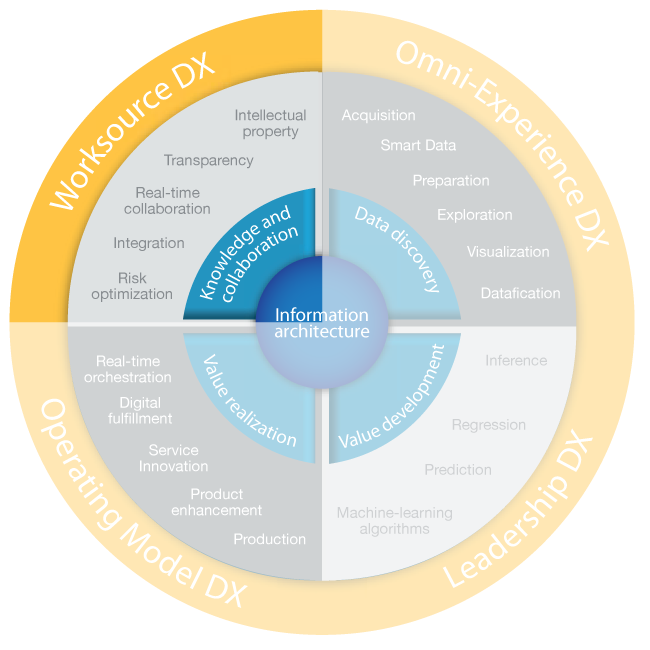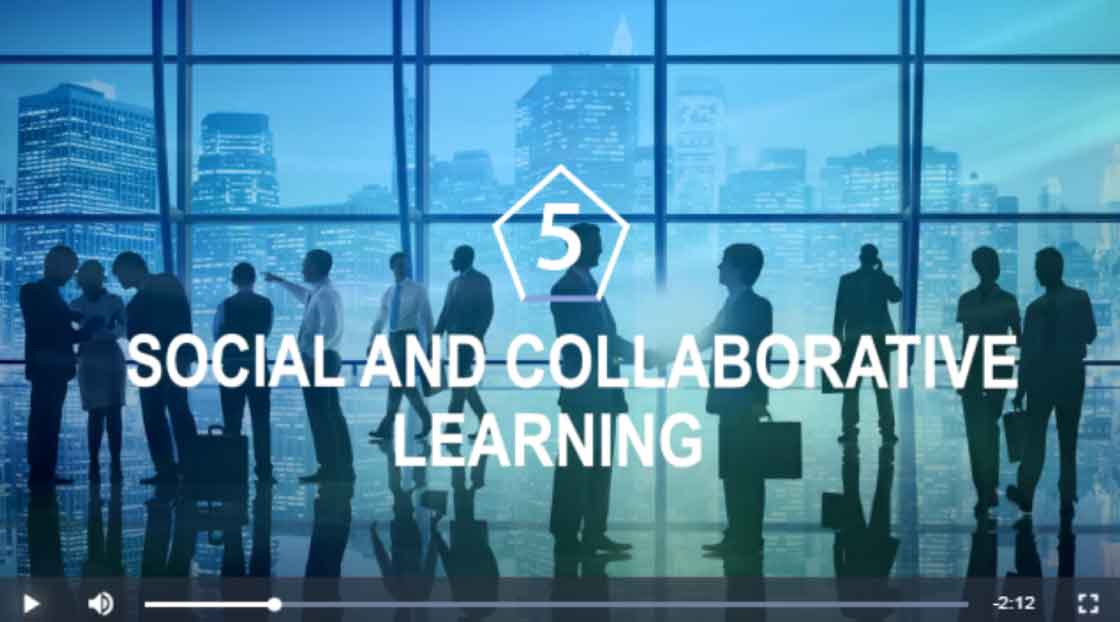
HR must deliver on
TRANSFORMATION
Digital Transformation (DX) refers to the application of digital technologies to fundamentally impact all aspects of business and society as a whole. It has become the source of new business models, enhanced experiences, and improved financial performance. The end of 2016, saw two-thirds of European Financial Times 500 enterprises place Digital Transformation at the center of their corporate strategy.

Introduction
IDC believes it is the responsibility of HR to address and deliver key elements of digital transformation
Involving the HR department in digital transformation projects is no longer a nice to have but a must-have. IDC research indicates that among HR professionals and line-of-business (LOB) managers, there is this common idea: HR is critical to the success of digital transformation.
Strategic HR enables organizations to automate processes, deliver self-service, and tap into talent. This frees HR to focus on knowledge, culture, and change
In 2016 IDC predicted that 2 out of 3 CEOs in the Financial Times Stock Exchange 500 will have digital transformation at the heart of their corporate strategy. In 2017 our research indicates that more than 85% of organizations have already undergone or started digital transformation projects, and this will continue to increase.
Only by transforming the HR department, its people, and its processes can an organization transform its business
The most dangerous way to approach the disruption caused by digital transformation is to apply the same processes and strategies that were relevant in the past. Placing your people at the center of the transformation effort requires new tools, new architecture, and a clear vision of the new role HR needs to play.
IDC has defined a scorecard, developed an assessment tool, and provided clear recommendations so that you can position your business and follow actionable insight
Any transformational process begins by assessing where things stand in the moment. Using these specially designed tools can help determine your strengths and weaknesses. It can also help you decide on the next steps as you embark on a journey of digital transformation.
Worksource Digital Transformation
Two-thirds of the CEOs of European Fortune 500 enterprises have digital transformation (DX) at the center of their corporate strategy. Transformation of the workforce, the way it is utilized, managed, and improved, is a central feature to this process and many HR professionals will be tasked with keeping pace and delivering change.

Disruption and Transformation
Organizations engaged in
Digital Transformation
Who is leading
Digital Transformation (%)
Top 4 Recognized Barriers to Successful Digital Transformation:
24%
People
Our organization does not have enough people with digital skills
22%
Knowledge
We lack a sufficient understanding of what digital transformation is and who can help us
21%
Financial Incentives
Our financial systems do not incentivize us to take the required risks for digital businesses
21%
Culture
Our organization does not have a risk-taking, innovation-driven culture
TAKEAWAY:
The fundamentals of digital transformation success will be based on HR transformation success.
Transformation of the workforce, and the way it is utilized, managed, and improved, is a central feature of this process. On top of everyday tasks and managing a team, many HR professionals will be tasked with keeping pace and delivering change.
This can only be achieved by HR helping to create an agile organization that meets the demands of the business, but also one that helps employees and managers become and remain engaged, productive, and focused. At the same time, HR must maintain a development path and training goals, and manage overall employee performance. This includes not only the talent you have, but also the talent you target. To achieve this, HR professionals must:
Drive HR transformation through a highly engaged workforce
Ensure HR becomes central to realizing transformation and continuous change
Create an agile, flexible, and reactive organization, built on a collaborative culture
Develop, retain, and attract the right talent into and within the business
TAKEAWAY:
Ensure your HR processes begin with the employee, involve the LOB, and result in a highly engaged and collaborative workforce.
HR Must Take a Seat at the Table
HR is central to delivering digital transformation, but very few HR leaders are heading this process … why?
This comes down to the traditional perception that HR professionals are less strategic and that their department (which may be under-resourced) does not possess the necessary skills or leverage within the business.
HR departments and HR leaders cannot afford to be seen as a process and policy driven section of the business. They must be seen as central to the business and demand a seat at the table.
TAKEAWAY:
Those leading digital transformation must be made aware of the "people" element, sooner rather than later …
Companies Look Internally for Resources
Q. When choosing an external service provider in support of your digital transformation, which type of provider would you prefer to use for each of the following stages?

Delivering Strategic HR
Strategic HR is Now a Must Have
Strategic HR is the process of delivering HR based on wider business objectives and outcomes, rather than process or administrative requirements — the bigger picture as opposed to (or as well as) the everyday.
Within four years (2012-2016), there has been a significant increase in the number of organizations that implement a formal talent management strategy.
Changing Priorities
One of the first steps to delivering HR transformation is automating processes and streamlining everyday tasks and admin. From here, you can drive employee engagement, which is central to productivity and talent retention.
TAKEAWAY:
The shift in importance placed on HR priorities signals a change in focus and a migration away from administration and towards performance and talent management. This has to be supported by automation and self-service tools.
TAKEAWAY:
Very few organizations are addressing this. LOOK FOR QUICK WINS.
Breaking the Vicious Circle
HR professionals need to break this vicious circle before it becomes a downward spiral. New tools and processes are one way to drive improved employee (and management) engagement, as well as streamline HR functions to enable a more strategic focus.

Realizing Transformation
Turn Your Human Capital Into Competitive Advantage
Attract
the best talent, into the best roles, with clear (and parallel) career development, as well as attracting employees from across departments.
Develop
talent across the organization, reskilling and retraining where possible, as well as empowering talent with the tools to enable this.
Retain
people, skills, and enagement by delivering opportunity and progression. Most critically, retain a highly engaged workforce.
Optimize
talent, skills, and potential (future capability). Ensure that the human capital and knowledge capital of the business exceeds the sum of the parts.
IDC has identified five key trends and actions to address the challenges of digital transformation and the development of HR
 EMPOWERING HR ACROSS THE BUSINESS
EMPOWERING HR ACROSS THE BUSINESS
- IDC research shows that organizations want an inclusive HR system that lets HR staff, managers, and employees become responsible for their own experience without complicated procedures.
- HR professionals must empower LOB and employees, turning everyone into "HR experts."
- How do I empower LOB? What software, processes, and policies do I need in place?
 IMPACTFUL HR DECISION MAKING
IMPACTFUL HR DECISION MAKING
- Analytics throughout the employee life cycle can deliver significant benefits, from identifying candidate suitability to determining flight risk and possible courses of action.
- 59% of the respondents in IDC’s Western Europe HCM survey said that analytics and dashboards are either very or extremely important when making decisions about investing in HCM software solutions.
 CONTINUOUS EMPLOYEE ENGAGEMENT
CONTINUOUS EMPLOYEE ENGAGEMENT
- 6% of Fortune 500 companies have abandoned rankings and annual reviews.
- IDC research shows more organizations are performing frequent appraisals.
- Continuous, "check-in" style personal development — engaging HR processes for performance, learning/development, and more regular feedback from peers and supervisors — is becoming the norm.
 MANAGING A FLEXIBLE WORKFORCE
MANAGING A FLEXIBLE WORKFORCE
- Only 10% of Western European HCM survey respondents were able to tap into talent wherever it is, through employment, contingent, contract, or freelancers.
- Yet up to 30% of large company HR spend goes towards contingent workers.
- With these employees now critical to the talent ecosystem, HR demands a redefinition of both the processes and how to best manage these people.
 SOCIAL AND COLLABORATIVE LEARNING
SOCIAL AND COLLABORATIVE LEARNING
- Over half of respondents in IDC's Western Europe HCM survey said that learning integration in a complete employee life-cycle solution is a high priority.
- HCM systems should also provide the opportunity for social learning, turning everyone into both "teachers" and "students."
- Best practices are better communicated, databases of experiences are created, and content distributed.
TAKEAWAY:
By addressing these initiatives, HR can deliver increased value but also gain time and insight to become more strategic and deliver increased value.
Multiple Stakeholders: One Common Goal
HR departments want a solution that frees up time from HR admin, allows for strategic inputs, and helps them deal with issues of planning, resourcing, and development.
Line-of-business managers want their staff to be engaged, with a high level of self-service, and to fulfill HR-related tasks with ease and on time.
Executives want to complete business transformation projects that will future proof their organizations. They care about efficiency, engagement, and productivity
Employees want self-service, zero-hassle, easy-to-use HR tools that help them keep track of their KPIs, their development goals, and their prospective paths.
The Steps to Delivering Strategic HR
Strategic HR means HR transformation
The successful system must include the following:- Ability to reduce mundane and repetitive tasks for user, HR staff, and managers
- Ability to interface with the existing data and offer insights and information that is tangible and useful
- Ability to incorporate feedback, training plans, and workforce planning into multiple and easy-to-use views
Next Steps
Playbook - Things to focus on
Recommendations
-
1
Move away from self-created HR silos, manual process, and ad hoc/ in-house solutions. Give your organization the tools to better manage the workforce.
-
2
Start with the automation of HR processes. Create time for your workforce and save cost for your business.
-
3
Focus on getting the right skills for the right positions. As the war for talent intensifies, secure a better inflow of talent.
-
4
Set best practices and policies to improve retention. Use analytics to identify high risk positions, prepare for succession.
-
5
Build your organization around employee engagement and satisfaction.
-
6
Deliver HR as competitive advantage for all stakeholders: attracting talent, delivering change, improving customer service and delivering sustained competitive advantage and growth.
-
7
Make HR departments part of the transformational process rather than a back office function!
-
8
Use the HR department as the spearhead for your Digital Transformation success.



